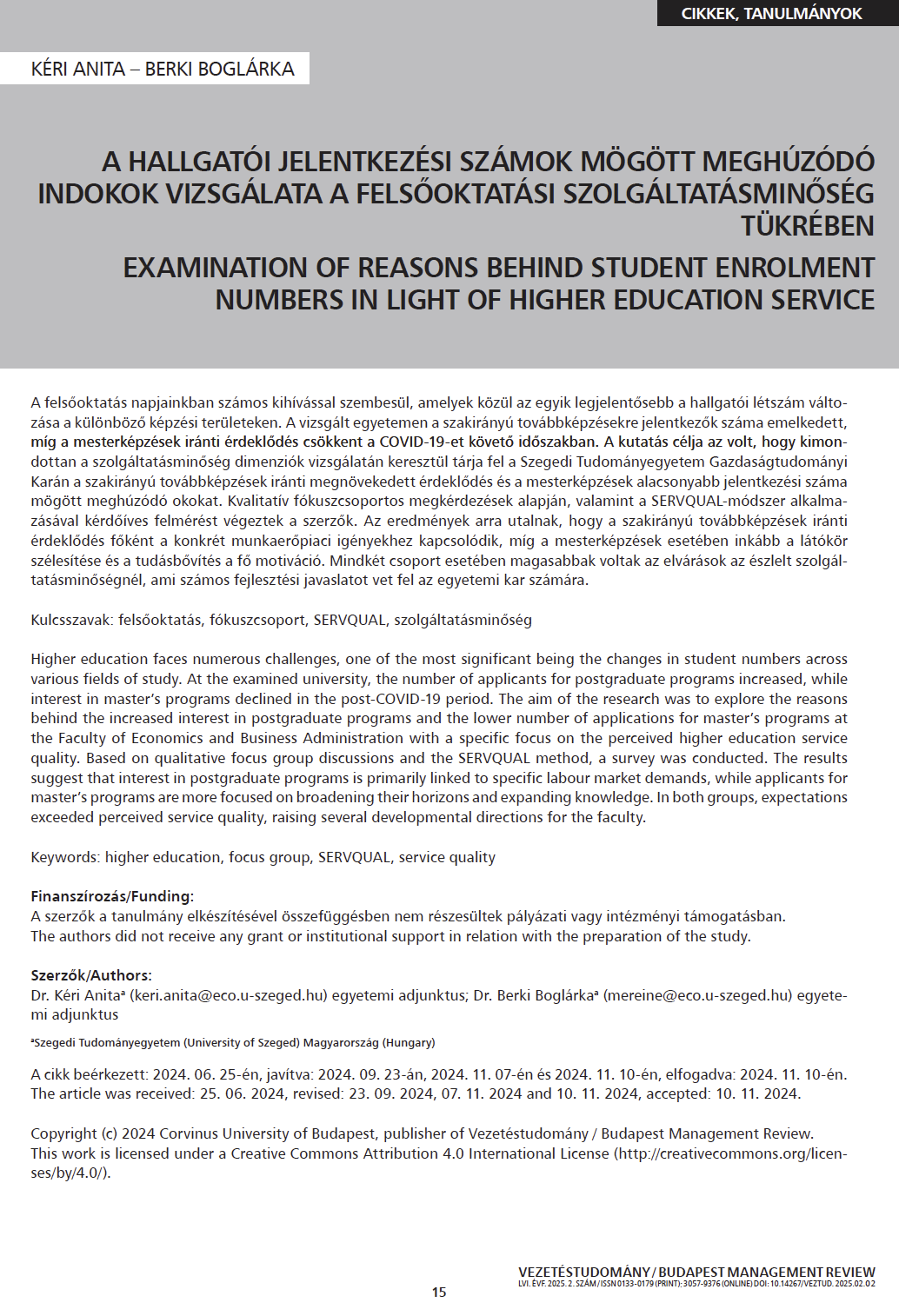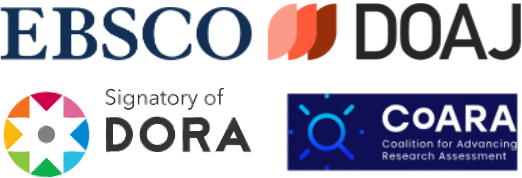Examination of reasons behind student enrolment numbers in light of higher education service
DOI:
https://doi.org/10.14267/VEZTUD.2025.02.02Keywords:
higher education, focus group, SERVQUAL, service qualityAbstract
Higher education faces numerous challenges, one of the most significant being the changes in student numbers across various fields of study. At the examined university, the number of applicants for postgraduate programs increased, while interest in master’s programs declined in the post-COVID-19 period. The aim of the research was to explore the reasons behind the increased interest in postgraduate programs and the lower number of applications for master’s programs at the Faculty of Economics and Business Administration with a specific focus on the perceived higher education service quality. Based on qualitative focus group discussions and the SERVQUAL method, a survey was conducted. The results
suggest that interest in postgraduate programs is primarily linked to specific labour market demands, while applicants for master’s programs are more focused on broadening their horizons and expanding knowledge. In both groups, expectations exceeded perceived service quality, raising several developmental directions for the faculty.
Downloads
References
Abdullah, F. (2006). The development of HedPERF: a new measuring instrument of service quality for the higher education sector. International Journal of Consumer Studies, 30(6), 569-581. https://doi.org/10.1111/j.1470-6431.2005.00480.x
Barakonyi, K (2010). A felsőoktatás versenyképességéről. Vezetéstudomány, 41(12), 4-19. https://doi.org/10.14267/VEZTUD.2010.12.01
Benedek, A., & Lőrincz, É.A. (2011). A pedagógusképzés és a szakképzés új összefüggései. Pedagógusképzés, 9(3-4), 113-126. https://doi.org/10.37205/TEL-hun.2011.3-4.07
Berács, J., Bander, K., Hubert, J., & Nagy, G. (2014). A felsőoktatási mobilitást akadályozó és ösztönző tényezők Magyarországon. 1. kötet. Tempus Közalapítvány.
Cronin, J.J. & Taylor, S.A. (1992). Measuring Service Quality: A Reexamination and Extension. Journal of Marketing, 56(7), 55-68. https://doi.org/10.2307/1252296
Cserné Adermann, G. (2020). Távoktatás: a levelezéstől a digitális oktatásig. Civil Szemle, 17(különszám), 7-22. https://ktk.pte.hu/sites/ktk.pte.hu/files/uploads/Flow-Mare%20publikaciok/CSz%20különszám%20előlappal.pdf
Faizan, A., Yuan, Z., Kashif, H., Pradeep, K., Nair, N., & Ari, R. (2016). Does higher education service quality effect student satisfaction, image and loyalty? A study of international students in Malaysian public universities. Quality Assurance in Education, 24(1), 70-94. https://doi.org/10.1108/QAE-02-2014-0008
Fazlul, I., Koedel, C., & Parsons, E. (2023). Free and reduced- price meal enrollment does not measure student poverty: Evidence and policy significance. Economics of Education Review, 94, 102374. https://doi.org/10.1016/j.econedurev.2023.102374
Gallarza, M.G., Seric, M., & Cuadrado, M. (2017). Trading off benefits and costs in higher education: A qualitative research with international incoming students. The International Journal of Management Education, 15, 456-469. https://doi.org/10.1016/j.ijme.2017.08.001
Hetesi, E., & Veres, Z. (2016). Nonbusiness marketing. Akadémiai Kiadó. https://doi.org/10.1556/9789630597494
Hrubos, I. (2024). Új megközelítések a felsőoktatási tanulásban és tanításban. Educatio, 33(2), 118-128. https://doi.org/10.1556/2063.33.2024.2.2
Jager, J., & Gbadamosi, G. (2013). Predicting students’ satisfaction through service quality in higher education. International Journal of Management Education, 11, 107-118. https://doi.org/10.1016/j.ijme.2013.09.001
Kenesei, Zs. (2017). A vevői elégedettség mérésének lehetőségei többdimenziós szemléletben. Statisztikai Szemle, 95(1), 29-50. http://dx.doi.org/10.20311/stat2017.01.hu0029
Kovács, L., & Takács, V. (2015). Az információbiztonsági vezető szakirányú továbbképzés tapasztalatai. Magyar Közigazgatás, 3(4), 85-99. https://folyoirat.ludovika.hu/index.php/ppbmk/article/view/2653/1918
KSH. (2023). Oktatási adatok. https://www.ksh.hu/s/kiadvanyok/oktatasi-adatok-20232024-elozetes-adatok/index.html
KSH. (2024). Felsőoktatás. https://www.ksh.hu/stadat_files/okt/hu/okt0020.html
Majó-Petri, Z., Szakál, P., & Görög, V. (2021). Karantén online oktatás a Szegedi Tudományegyetemen: Mit tapasztaltak a diákok? In Buda A. & Molnár Gy. (szerk.), Oktatás – Informatika – Pedagógia 2021 (pp. 170-183). Debreceni Egyetem Nevelésés Művelődéstudományi Intézet.
Mekic, E., & Mekic, E. (2016). Impact of higher education service quality on student satisfaction and its influence on loyalty: Focus on first cycle of studies at accredited HEIs in BH. In ICESoS 2016, Proceedings (pp. 43-56). International Burch University.
Molnár, L., Papp, A., Piskóti, I., & Molnárné Konyha, Cs. (2015). Marketing mesterszak hallgatói szemmel. In Marketing hálózaton innen és túl: Az Egyesület a Marketing Oktatásért és Kutatásért XXI. Országos Konferenciája (pp. 36-45). EMOK.
Molnár, Gy. (2014). Digitális kompetenciák és IKT alapú megoldások a felsőoktatásban. Szakképzés- és Környezetpedagógia, 4(1), 6-14. http://www.epa.hu/02900/02984/00004/pdf/EPA02984_edu_2014_1.pdf#page=6
Msosa, S.K. (2021). Service failure and complaints management in higher education institutions. International Journal of Research in Business and Social Science, 10(3), 514–521. https://doi.org/10.20525/ijrbs.v10i3.1098
Negricea, C.I., Edu, T., & Avram, E.M. (2014). Establishing influence of specific academic quality on student satisfaction. Procedia - Social and Behavioral Sciences, 116, 4430-4435. https://doi.org/10.1016/j.sbspro.2014.01.961
Parasuraman, A., Berry, L.L., & Zeithaml, V.A. (1991). Perceived service quality as a customer-based performance measure: An empirical examination of organizational barriers using an extended service quality model. Human Resource Management, 30(3), 335-364. https://doi.org/10.1002/hrm.3930300304
Polónyi, I. (2015a). Kik lesznek mesterek? Adalékok a felsőoktatási mesterképzés értékeléséhez. Pedagógiai Szemle, 5-6, 50-67. https://folyoiratok.oh.gov.hu/uj-pedagogiai-szemle/kik-lesznek-mesterek#main-content
Polónyi, I. (2015b). Az ezredforduló hazai oktatása. Új Mandátum Könyvkiadó.
Polónyi, I. (2023). A hazai kétszintű felsőoktatási képzés néhány jellemzője. Köz-Gazdaság, 18(4), 53-92. https://doi.org/10.14267/RETP2023.04.05
Qin, L., Shi, C., & Li, B. (2022). Examining master of nursing specialist postgraduates’ perception of educational service quality in clinical practice base: The SERVPERF model. Research Square. https://doi.org/10.21203/rs.3.rs-1691464/v1
Randheer, K. (2015). Service quality performance scale in higher education: Culture as a new dimension. International Business Research, 8(3), 29-41. https://doi.org/10.5539/ibr.v8n3p29
Sultan, P., & Wong, H. Y. (2013). Antecedents and consequences of service quality in a higher education context: A qualitative research approach. Quality Assurance in Education, 21(1), 70‐95. https://doi.org/10.1108/09684881311293070
Surman, V. (2021). Szolgáltatásminőség mérése és értékelése a felsőoktatásban – Szolgáltatásminőség-keretrendszer fejlesztése projektfeladat-típusú kurzusokhoz (Doktori értekezés). Budapesti Műszaki és Gazdaságtudományi Egyetem. http://hdl.handle.net/10890/15346
Surman, V., & Szabó, T. (2020). A minőség biztosításának kihívásai a magyar felsőoktatásban. Vezetéstudomány. 51(KSZ), 101-113. https://doi.org/10.14267/VEZTUD.2020.KSZ.09
Szabó, K., Juhász, T., & Kenderfi, M. (2022). Felsőoktatás a COVID-19 árnyékában: Hazai tapasztalatok oktatói oldalról. Vezetéstudomány, 53(6), 2–12. https://doi.org/10.14267/VEZTUD.2022.06.01
Tan, K.C., & Kek, S.W. (2004). Service quality in Higher Education using an enhanced SERVQUAL approach. Quality in Higher Education, 10(1), 17–24. https://doi.org/10.1080/1353832242000195032
Teeroovengadum, V., Kamalanabhan, T.J., & Seebaluck, A.K. (2016). Measuring service quality in higher education. Quality Assurance in Education, 24(2), 244- 258. https://doi.org/10.1108/QAE-06-2014-0028
Tsiligiris, V., Kéri, A., & Cheah, J.E.T. (2022). Exploring the relationship between student individual culture and service quality expectations in higher education. Quality Assurance in Education, 30(1), 51-72. https://doi.org/10.1108/QAE-11-2020-0137
UNESCO. (2024). Key figures. https://www.unesco.org/en/higher-education#:~:text=There%20are%20around%20254%20million,differences%20between%20countries%20and%20regions.
Veres, Z. (2021). A szolgáltatásmarketing alapkönyve. Akadémia Kiadó. https://doi.org/10.1556/9789634546412
Zsatku, B., & Kováts, G. (2022). The impact of institutional governance reforms on organisational culture – Two case studies from Finland and Hungary. Hungarian Educational Research Journal, 13(1), 64-85. https://doi.org/10.1556/063.2022.00165

Downloads
Published
How to Cite
Issue
Section
License
Copyright (c) 2025 Corvinus University of Budapest, publisher of Vezetéstudomány / Budapest Management Review

This work is licensed under a Creative Commons Attribution 4.0 International License.
Authors assign copyright to Vezetéstudomány / Budapest Management Review. Authors are responsible for permission to reproduce copyright material from other sources.

